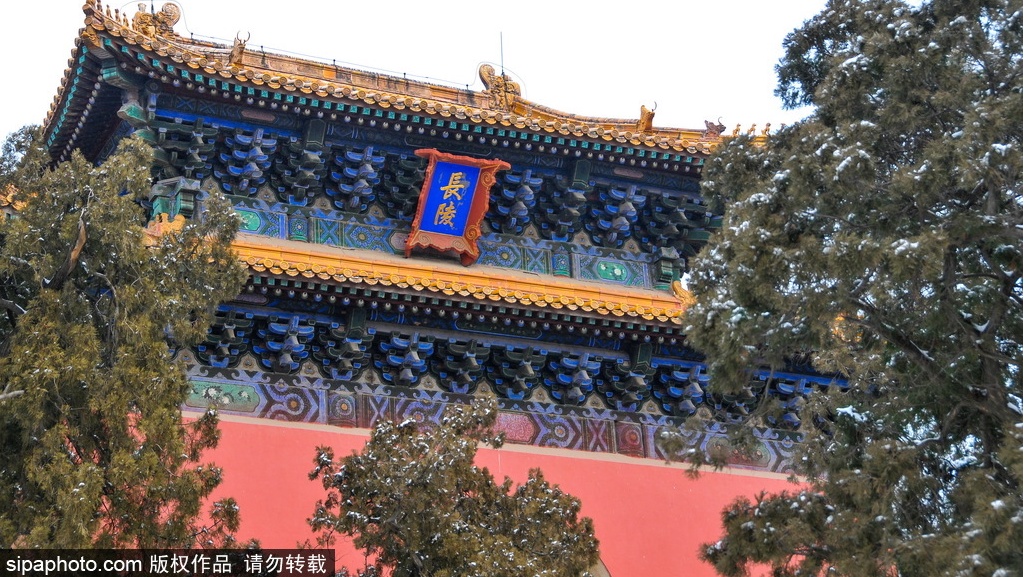Changling Tomb is a famous tomb of the Thirteen Tombs of the Ming Dynasty. On the eastern side of the first courtyard stand a dragon stele and a pavilion housing the stele, which were built in the 21st year during Emperor Jiajing’s reign. The stele pavilion, with a double eave and hip and gable roof, is archaic and solemn. Entering the pavilion, we will see the rectangular base carved with the pattern of sea and mountains. The symbol of the stele, posing like a turtle, is a crawling dragon, whose body is covered with protruding scales. Its dorsal fin reaches towards its thick and strong tail. In ancient China, the dragon is an auspicious animal in people’s mind.

Standing on the dragon is a stele about three meters in height, with a unique top. The dragon winding around the stele pokes his head out as if it were about to plunge into the sea or fly onto the sky. The stele is definitely a rare stone carving masterpiece. As for its origin, we have to mention the Jiajing Emperor. In the 16th year during Jiajing Emperor’s reign, the then Shizong Emperor Zhu Houcong, when building his own tomb, found that only the Changling Tomb had a stele of divine merits and sacred virtues, while other six tombs, including Xianling, Jingling, Yuling, Maoling, Tailing and Kangling, did not have such a stele.
The emperor then summoned the grand secretary Xia Yan and ordered to build steles of divine merits and sacred virtues or the crouching turtle steles for the six tombs. Moreover, in order to pay tribute to Chengzu Emperor Zhu Di, a stele of emperor’s achievements was also built in the Changling Tomb. Shizong Emperor poured all his heart into building of this stele, as he and Chengzu Emperor both ascended to the throne from merely local lords. Chengzu seized the throne in the name of waging a war against riots, and Shizong fought all the way to the throne. They started with similar identities and achieved identical ends. Apart from this, Shizong also meant to use the flourishing age Emperor Yongle created during the reign to raise his own prestige. So he changed Chengzu Emperor Zhu Di’s posthumous title from “Taizong” to “Chengzu” and enshrined him in the Imperial Ancestral Temple as an irreplaceable emperor. He also ordered to replace the turtle stele on the pedestal of the tablet with a dragon stele. That is the dragon stele that we can see. From all the reasons above, we can see the real reason why Emperor Shizong built the stele for Chengzu.
When the seven steles were completed, Yan Song, the Director of the Board of Rites, submitted memorials to Emperor Shizong to write inscriptions for the steles. However, it was unlikely for the meddle-headed emperor, who was addicted to Taoism and less cared about state affairs, to write beautiful and convincing inscriptions to extol the former emperors who were mostly mediocre in political performances. Therefore, though the steles were long in place, there was not a word inscribed on them. In the 16th year during Emperor Shunzhi’s reign in the Qing Dynasty, Shunzhi Emperor visited the Ming Tombs. On seeing that the buildings were terribly dilapidated, and the trees nearby were almost hacked down, Shunzhi Emperor ordered the Ministry of Works in feudal China to restore the mausoleums. Tomb guards were also deployed to take care of the tombs. The emperor also ordered the governor Chang Ping to send officials to inspect and check the tombs once or twice a year. Shunzhi Emperor’s edict for protecting the Ming Tombs was even carved on the front of the dragon stele in Manchu language and Chinese. In addition, the back and left side of the stele were carved with poems by Qianlong Emperor and Jiaqing Emperor in the Qing Dynasty. Therefore, the stele was an object heavily guarded by special institutions in the dynasty. The entire dragon stele boasts a novel and unique design, delicate carvings, and exquisite calligraphy, fully displaying the extraordinary charm of ancient Chinese carving art.



